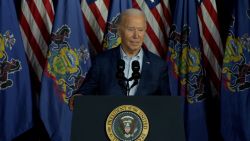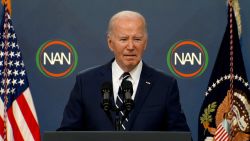The National Oceanic and Atmospheric Administration on Friday disavowed a tweet from the National Weather Service’s Birmingham, Alabama, office that had contradicted President Donald Trump’s false assertion that Hurricane Dorian was likely to hit the state.
In a statement attributed to an unnamed NOAA spokesperson, the agency said Trump had been given information from August 28 until Monday that Dorian could impact Alabama.
“From Wednesday, August 28, through Monday, September 2, the information provided by NOAA and the National Hurricane Center to President Trump and the wider public demonstrated that tropical-storm-force winds from Hurricane Dorian could impact Alabama,” the statement read. “This is clearly demonstrated in Hurricane Advisories #15 through #41, which can be viewed on the center’s website.
“The Birmingham National Weather Service’s Sunday morning tweet spoke in absolute terms that were inconsistent with probabilities from the best forecast products available at the time.”
Dan Sobien, president of the National Weather Service Employees Organization, lambasted NOAA’s characterization of events and defended the agency’s employees.
“Let me assure you the hard working employees of the NWS had nothing to do with the utterly disgusting and disingenuous tweet sent out by NOAA management tonight #NOAA,” he tweeted Friday.
It’s the latest development in a story that has consumed Washington, even as the deadly hurricane slowly creeps up the East Coast. The storm began battering North Carolina and South Carolina on Thursday and made landfall in the Tarheel State’s Outer Banks on Friday morning.
Earlier in the week, Dorian killed at least 30 people in the Bahamas and left the island nation utterly devastated. The death toll there is expected to rise in the coming days, as hundreds are missing.
But while hundreds of thousands of Americans were evacuating from their homes and Bahamians were attempting to survive one of the worst storms to ever hit the island, the President has continued to attempt to prove that he wasn’t wrong when he falsely said the storm was headed for Alabama.
The President initially tweeted on Sunday morning that Alabama was among a list of states that “will most likely be hit (much) harder than anticipated” by Dorian. Forecasts from that time did not show the storm heading toward Alabama, though earlier forecasts did show small portions of the state potentially being in Dorian’s path.
Shortly after that tweet, the National Weather Service’s Birmingham office tweeted that Alabama would not be affected by Dorian.
“Alabama will NOT see any impacts from #Dorian. We repeat, no impacts from Hurricane #Dorian will be felt across Alabama,” the tweet read. “The system will remain too far east.”
Later Sunday, Trump repeated his statement.
“And, I will say, the states – and it may get a little piece of a great place: It’s called Alabama. And Alabama could even be in for at least some very strong winds and something more than that, it could be,” Trump told reporters at a briefing on the storm. “This just came up, unfortunately. It’s the size of – the storm that we’re talking about. So, for Alabama, just please be careful also.”
Those mistaken remarks received criticism that apparently irked the President, as he began tweeting criticism of reporters for pointing out that, at the time he was speaking on Sunday, Alabama was not expected to be hit by the storm. On Wednesday, Trump’s attempts to prove he was correct veered into the absurd when he showed off an apparently altered map of a forecast from NOAA that showed a black line drawn in marker over Alabama to imply the storm’s track would have taken it deep into the Gulf state.
That was followed by multiple tweets from the President attempting to back up his statement, many of which featured outdated forecasts from days before he had made his remarks on Sunday. CNN was first to report on Thursday that Trump also made his case to a Fox News White House reporter that he was right about Dorian’s path.
CNN’s Daniel Dale, Brandon Miller and Caroline Kelly contributed to this report.
















